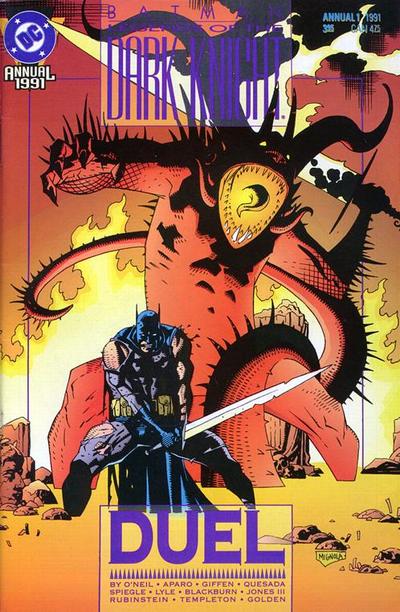The cover of the 4th issue of Flinch (September 1999), is actually a photography by Stephen John Phillips, digitally altered by José Villarrubia. In only 4 issues, Flinch had professional illustrators, comic book artists, and also photographers leaving their mark on Vertigo’s horror anthology. Although in general I’m not a fan of photographs being used as covers, I must say I like the way Villarrubia turns the image into something visually appealing.
“A Gift of Friendship” is a story written, penciled, inked and even lettered by Kent Williams. The only thing that Williams doesn’t take care of is the coloring (which is done by Sherilyn van Valkenburgh). One would expect a very cohesive proposal since the same person is doing pretty much everything. However Williams’s story is unnecessarily confusing and in the end it doesn’t work as a whole.
Ty Templeton writes, pencils and inks “Fair Trade”, which is a very amusing story about a man who is going to sell his soul to the devil, the only problem is that there is more than one devil, and they all offer him amazing rewards in exchange for his soul. Templeton takes the basic elements of horror and turns them into a fast-paced comedy. I’d say this is one of the few cases in which humor actually fits into a horror anthology.
My favorite story, by far, is “Playing Dead”, written by veteran horror storyteller Bruce Jones and penciled and inked by Paul Gulacy. This is a black and white story that takes place in the 19th century. A man takes advantage of a demented woman who confuses him with her deceased husband. Gulacy has always been a magnificent artist, but these pages are especially striking. There is a lot of detail but also a unique sense of composition, every panel blends elegantly into the next one, and the page as a whole always stands out.
In many ways, “Playing Dead” is a tale of survival, but it’s also the logical consequence of taking a lie to the extreme. At first the protagonist is content with having sex with this strange woman, and he’s relieved after leaving his past behind and pretending to be someone else. But when he finds the diary of the dead husband the suspense increases.
________________________________________________________________________________________________________
________________________________________________________________________________________________________
La portada del cuarto número de Flinch (setiembre de 1999), es en realidad una fotografía de Stephen John Phillips, alterada digitalmente por José Villarrubia. En sólo 4 números, Flinch tuvo ilustradores profesionales, artistas de cómics y también fotógrafos que dejaron su huella en esta antología de terror de Vertigo. Aunque en general no soy entusiasta de las fotografías que se utilizan como portadas, debo decir que me gusta la forma en que Villarrubia convierte la imagen en algo visualmente atractivo.
"Un regalo de amistad" es una historia escrita, dibujada a lápiz, entintada e incluso rotulada por Kent Williams. Lo único de lo que Williams no se ocupa es del color (a cargo de Sherilyn van Valkenburgh). Uno esperaría una propuesta bien cohesionada ya que la misma persona hace casi todo. Sin embargo, la historia de Williams es innecesariamente confusa y, al final, no encaja del todo.
Ty Templeton escribe y dibuja “Comercio justo”, una historia muy divertida sobre un hombre que le va a vender su alma al diablo, el único problema es que hay más de un diablo, y todos le ofrecen increíbles recompensas a cambio de su alma. Templeton toma los elementos básicos del terror y los convierte en una comedia trepidante. Diría que este es uno de los pocos casos en los que el humor realmente encaja en una antología de terror.
Mi historia favorita, de lejos, es "Haciéndose el muerto", escrita por el veterano narrador de historias de terror Bruce Jones y dibujada a lápiz y entintada por Paul Gulacy. Esta es una historia a blanco y negro que tiene lugar en el siglo XIX. Un hombre se aprovecha de una mujer demente que lo confunde con su difunto esposo. Gulacy siempre ha sido un artista magnífico, pero estas páginas son especialmente llamativas. Hay muchos detalles pero también un sentido de composición único, cada viñeta se mezcla elegantemente con la siguiente y la página en su conjunto siempre sobresale.
En muchos sentidos, "Haciéndose el muerto" es una historia de supervivencia, pero también es la consecuencia lógica de llevar una mentira al extremo. Al principio, el protagonista se contenta con tener sexo con esta extraña mujer, y se siente aliviado después de dejar atrás su pasado y pretender ser otra persona. Pero cuando encuentra el diario del difunto marido, aumenta el suspenso.




















